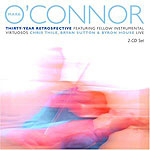
One great fiddler
|
This review first appeared in the Winter 2003 issue of Turbula.
No violinist outside the late Papa John Creach has ever been as at home in as broad a variety of settings as Mark O'Connor. And Creach, blessed though he was, never had the pure talent that O'Connor possesses.
The truth is, O'Connor is one of the best fiddlers around. His playing is both graceful and energetic; it is simultaneously lithe and forceful. And while he never puts technique ahead of artistry, when it is called for he can play as much fiddle as anyone.
These points are driven home again and again throughout the course of listening to a new double-CD live retrospective of O'Connor's career. Bluegrass to classical, new age to jazz – there is seemingly no style of American music that O'Connor hasn't tackled. Mastered, actually – for O'Connor is positively outstanding in just about every style.
If there's a surprise to be found in this set, it's how good his songs sound in a live, concert setting after having been (mostly) originally recorded in a studio setting. "Bowl of Bula," which opens the set, originally appeared on O'Connor's 1984 new age album, "Meanings Of" – and had a heavily produced, studio feel to it. But the acoustic quartet (mandolin, guitar and bass in addition to violin) O'Connor has assembled for this recording gives the song a spare yet rich sound that works in some ways better than the original. Regardless, it's a great composition with a catchy melody that sticks in your head.
O'Connor's reputation was first earned while winning fiddle contests in the 1970s, and later honed in the studios of Nashville in the '80s – and there are plenty of bluegrass reels and country songs to please fans of those periods on this album.
In the '90s, O'Connor teamed with classical cellist Yo-Yo Ma, jazz/classical trumpter Wynton Marsalis, bassist Edgar Meyer and folk singer James Taylor for a series of albums giving Americana a classical treatment a la Aaron Copeland – and there are a few cuts from that era as well.
And by the time of the new millennium, he was exploring the swing jazz styles of Stephane Grappelli and Stuff Smith.
That's here, too.
Perhaps the most impressive part of what is a very impressive album is how good everything sounds together. O'Connor and his band can go from swing to bluegrass to new age to country and back again without ever sounding jarring or as if they're changing gears.
In the end, all these different styles and disparate influences become, in his hands, Mark O'Connor music – a gorgeous slice of just about every type of American music ever laid down.
